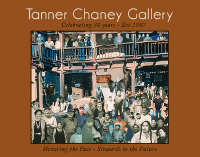INDIAN TRADERS and PAWN
The Navajo call them “Naalyehe ya sidaho,” which translates to “a person who sits for things of value.” Trading has existed in the Southwest since before recorded history. Inter-tribal traders found a ready market for ornamental items (used for ceremonial purposes, as a means of showing personal stature within the community, or as a store of wealth). Turquoise, in particular, was believed to have healing powers as well as being valued for its beauty, and was traded centuries ago all the way down to the tip of South America in return for copper bells and parrot feathers.
The introduction of silver to the Southwest by the Spanish added a new dimension. The Indians pounded it, shaped it, set stones into it, and created unusual and stunning pieces of jewelry.
As the West developed, traders began to settle along the Little Colorado River. Most had European origins and were familiar with the use of fine jewelry as security for business ventures and loans. They felt quite comfortable granting lines of credit to their Indian neighbors in exchange for jewelry, weavings and beadwork.
This system of pawning goods became an intrinsic part of life in Indian Country. Over the years, a mutual dependency developed between the two groups. Traders would extend credit for pawned jewelry in the fall which would carry the Indian families through the winter.
Indian traders were more than bankers providing a repository or grocers with durable goods. In these isolated outposts, Indian traders could be relied on in times of crisis, too. They were the ambulance drivers, the neighbor and friend to the Navajo on the reservation. And in the very early days (late 1800s), the traders were the ones who bridged the worlds, opening up commercial possibilities for the Navajo. In 1853, Indian agent Henry Dodge moved to a house near Fort Defiance and married a Navajo woman. Dodge brought with him a blacksmith and a Mexican silversmith. Years later, after the Navajo were released from their five year confinement at Fort Sumner (Bosque Redondo), At sidi Sani came to the Indian agency to observe the two smiths at work and refine his metalworking skills.
In the late 1880s, J.L. Hubbell hired several Mexican silversmiths to teach the craft to Navajo at his trading post in Ganado, Arizona. He later imported Persian turquoise for trade to the Navajo. Eventually, the local supply of turquoise increased as more mines were opened.
Pawn or Antique?
Much of what is called old pawn is a misnomer. Soaring demand has all but eliminated authentic pawn from the market. In addition, there is just pawn that ends up being abandoned and available for sale. Also, pawn itself does not necessarily mean old. A piece could be made yesterday and pawned today, and that would qualify as pawn (authentic pawn would have the pawn ticket attached).
What most people are referring to when they ask about pawn is for authentic old pieces of jewelry made by Indians. At Tanner Chaney we refer to our old pieces as antique. In the world of Indian jewelry, “antique” can refer to anything created before 1940. Knowledgeable traders can date a piece by determining whether the silver was hand-pounded, chiseled, or filed; whether it is ingot or coin silver; whether the turquoise is natural or treated; and whether the piece is signed or stamped (a practice that began about 1950 but not done in earnest until the 1970s).
At Tanner Chaney, many of the estate and antique pieces have a special history with us. That's because in many cases, we sold the pieces to the collector decades ago and and so it's like seeing an old friend, welcoming that friend into our home. And then we help that piece find a new home. In many ways, just like traders of the past we have a special history with our artists, too, as friends, confidants, and people they can rely on. It's a relationship built on mutual trust and respect, just like the traders of old.

